 | E-mail to Birds Korea |
 | KWBS |
in the Region
 | The Oriental Bird Club |
 | BirdLife International (Asia) |
May
Like April, a great birding month. Temperatures begin to climb with day maxima often reaching 25°C by the end of the month, though feeling cooler on offshore islands due to low sea temperatures and wind. Fog can temporarily limit birding, while also causing spectacular falls of migrants.
Migration continues, and guided tours to estuaries or offshore islands can expect many spectacular days. Especially in the first week, diversity can be exceptional. Lesser Sandplovers, Red-necked Stints, Broad-billed and Spoon-billed Sandpipers peak at Saemangeum and other key areas, while Chestnut and Little Buntings begin to outnumber Yellow-throated and the very common Black-faced Bunting. Mugimakis, Dark-sided and Grey-streaked Flycatchers also start to arrive, peaking in the second and third weeks of the month. Brown and Tiger Shrikes, Siberian Rubythroats and Broad-billed Rollers add colour and quality to the birding mix. By late May locustella warblers (Gray's, Pallas's, Middendorf's, Styann's Grasshopper and Lanceolated) arrive on western islands. In forests Ruddy Kingfisher and Fairy Pitta are in territory and vocal, though still elusive and easily disturbed. Korean breeding Chinese Egrets and Black-faced Spoonbills remain widespread at the best sites, and Saunders's Gull also sometimes nest.
May is a prime month for finding national rarities. Korean firsts in May have included: in 2000, Ortolan Bunting and Northern Wheatear; in 2001, Himalayan Swiftlet and Asian Koel on Gageo Island, and Black Tern at Seosan; in 2002, Long-tailed Skua; in 2003, Isabelline Wheatear and Chinese Song Thrush; in 2004, an Orange-headed Thrush on Hong Island; and in 2005 three Tickell's Leaf Warblers on Socheong.
(The following records are a compilation of our own sightings and records sent in by other observers. As well as being posted on the Birds Korea website(s), selected records are also forwarded to other Korean-language birding websites; records of threatened species are arranged and forwarded to Birdlife International and national authorities when appropriate; flag images and records are passed to bodies responsible for their coordination throughout the flyway; and all records sent to us are used to compile annual reports and to support the evolving understanding of the status of many of Korea’s birds.)
Baebongsan, May 31

A brief visit to this patch of woods in Seoul found all was quiet save for family groups of Great and Varied Tits, Tree Sparrows, Brown-eared Bulbuls and Magpies - all feeding young fledglings.
The resident pair of Chinese Sparrowhawks emerged near sundown to put on a fairly spectacular courtship/pair-bonding display- soaring in close symmetry, clasping talons and tumbling in mid air.
Hong Island, May 30
Korea's first Spotted Dove Steptopelia chinensis - first found and Photographed by Park Jong-Gil of the National Parks Migratory Bird Centre on May 23rd - was re-found today on Hong Island.
Socheong Island AM, Ferry, May 28
An exceptionally quiet start to an overcast early morning, especially considering the heavy rain of the 27th. Some movement appeared to start at around0800 am when the cloud cover broke, however, when first a Chinese Egret flew east over the sea, followed by 3 or 4 Pechora Pipit, and a third Light-vented Bulbul apparently arrived in at the far southwest of the island. The same, or a fourth Light-vented Bulbul, was then also found in the main village two hours later.
Although other grounded migrants were largely limited to low tens of Arctic Warbler, also of note were three Intermediate Egret, one or two singing Northern Hawk Cuckoo and ca 6 Lanceolated Warbler, while an unusual sight was provided by an adult Peregrine catching a Chinese Sparrowhawk, which it then carried off towards a single begging juvenile.
Between 10 AM and 1 PM (when the ferry departed), a constant trickle of hirundines also moved due north, including 5+ Asian House Martin, and more surprisingly a Northern House Martin (the fifth record of the species in South Korea this year known to Birds Korea), while a dozen White-throated Needletails joined loosely with small groups of Pacific Swift, also all moving north rapidly. Highlight of the day was contained within one of these swift flocks. An incoming group of 20 birds was picked up on call - a decidely thinner, softer and flatter swift-call than typical of Pacific Swift, very strongly reminiscent of Common Swift Apus apus, and clearly different from the call given by Pacific Swift the same morning. Binocular and brief scope views then revealed that 3 or 4 individuals in the flock were slightly paler brown than the majority, and that these paler birds also apparently lacked a white rump, even when the white rump bands were visible on the majority of darker-looking birds. Based on the difference in call and plumage tones these are all therefore presumed to have been Common Swift. While Common Swift breeds east across China, and despite annual claims of all-dark swifts here, the species has still not yet been formally documented in South Korea.
From the ferry, few birds noted, with best being a group of 8 Crested Honey Buzzard ca 30 km southeast off Socheong apparently heading due north low over the sea.

Socheong Island, May 27
Heavy rain from very early morning through until early evening prevented much time in the field, though it was apparent that few birds had arrived, with only a dozen or so Chinese Sparrowhawk, a Great and an Intermediate Egret, and a single Richard's Pipit and Yellow Wagtail noted in a 2-hour walk.
Socheong Island, May 26
With the first bright conditions for almost a week, most effort was concentrated on counting raptors from the main count point above the village. Counting between0900 and 1100 and again from 1445-1845 produced (fairly low) totals of 29 Crested Honey Buzzard, 48 Grey-faced Buzzard, 196 Chinese Sparrowhawk, 1 Japanese Lesser Sparrowhawk, 2 Kestrel, 3 Northern Hobby and a single Peregrine. Other species of note from there were 1-2 singing Northern (Hodgson's) Hawk Cuckoo, 6 White-throated Needletailed Swift, 13 Pacific Swift, 2 Sand Martin, 6 Asian House Martin, 2 Pechora Pipit, a Thick-billed Shrike, a Gray's Grasshopper Warbler, and a mixed group of 4 Dark-sided, 2 Brown and 3 Grey-Streaked Flycatcher giving excellent and prolonged views.

Socheong Island, May 25
Largely thinly overcast through the day, with little evidence of any arrivals until very late in the afternoon, and only 66 species logged after the massive clear out on the 24th. Species of most note included 2 Light-vented Bulbul still, 5 Brown Shrike (including yet another one with an obvious white primary patch), 2 Japanese Grosbeak and now 5 Black Drongo.
Socheong Island, May 24
With clear(ish) skies and still lingering fog, large numbers of passerines were logged moving through and away from the island - with e.g. 90 warblers and flycatches counted flying out to sea in only 20 minutes at midday.
A very long search for yesterday's coucal proved unsuccessful, though a Spangled Drongo showing well in the same area provided some much-needed compensation! Other species of note included another Greater Short-toed Lark, another male White-throated Rockthrush and at least 3 Thick-billed Shrike.

Socheong Island, May 23
Dense fog throughout much of the day, and a concerted effort to cover as much of the island as possible between06:30 and 19:00...
Outstanding highlight of the day came early, when a coucal flushed up off the track and away down the hillside into "secret gully". Fully expecting it to be a Lesser (now recorded twice in South Korea - in June 2005, and one earlier this month), the bird quickly returned to glide low past me, and up into some pine trees, where it was immediately lost to sight. On these return views the bird appeared Goshawk-sized, very long- and ragged-tailed and rather heavy-billed, and looked to have a dark leading edge to the underwing (views inadequate, and possibility of effect of light/angle cannt be ruled out); the head was clearly glossy-black lacking any kind of head streaking (binocular views good enough to see glint of light in the bird's eye), the wings were bright rufous-brown, and there was no streaking on or dusky tips to the wings and no streaking on the mantle. Of potential note, the lower nape/upper mantle was also solid black, extending as a deep rounded wedge into the rufous of the lower mantle, which in turn was concolorous with the wings. A long search ensued, but the bird was not seen again. Lacking information on the plumage/appearance/separation of Lesser and Greater Coucal in the north of their ranges (ie in China), we would welcome advice on references or notes on identification.
Further species of note during the day included the 2 Light-vented Bulbul still, a female Siberian Thrush, a male White-throated Rockthrush, 4 Black Drongo, a Daurian Starling, 88 Arctic, 54 Pale-legged(/Sakhalin) and 40 Two-barred Greenish Warblers.
Hong Island, May 23
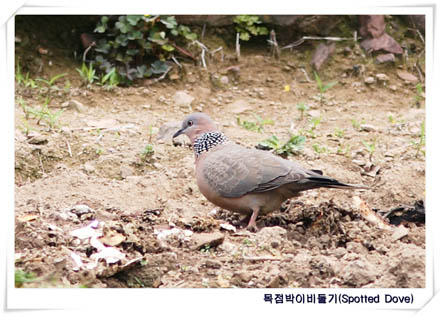
Photo © Kim Sung-Hyun (National Parks Migratory Bird Centre)
South Korea's first Spotted Dove Steptopelia chinensis was found and Photographed today by Kim Sung-Hyun of the National Parks Migratory Bird Centre on Hong Island. (The dove was subsequently re-seen on the 30th after being missing all week.)
Socheong Island, May 22
With heavy rain through the morning, expectations were high of some interesting arrivals. However, numbers remained fairly low throughout the day, with most interesting species being Purple Heron (3), 6 Black Drongo and 2 Light-vented Bulbul (presumably newly arrived?).
Seungbong Island, May 21
Overhead movement continued in the morning with 4 Greater Short-toed Larks, several more Dollarbirds, Black-naped Orioles and Richard's Pipits. Migrating raptors showed well with c.15 Chinese Sparrowhawk, 3 Amur Falcon, 1 Northern Hobby, 1 Grey-faced Buzzard and an Oriental Honey Buzzard.

1 Gray's Grasshopper Warbler and 1 Indian Cuckoo were heard .In woodland, several Long-tailed Tits, 1 Oriental Scops Owl (heard), plentiful Asian Brown and 2 Mugimaki Flycatchers. Low-lying scrub held several Radde's, a Dusky, and a few singing Lanceolated Warblers, making a total of 50 species found on the island.

Geum Estuary, May 21
Good views down to 200m for several minutes of an adult Spoon-billed Sandpiper with a small group of Red-necked Stint on the north side of the Geum about0.5 km below the dam.
Socheong, May 21
A total of 72 species logged for the day, with reduced numbers of warblers (only 60 Arctic and 10 Two-barred Greenish logged for example), and highlights coming in the form of excellent views of a perched Northern Boobook, single Greater Short-toed Lark and Chinese Blackbird, and now 5 Black Drongo.
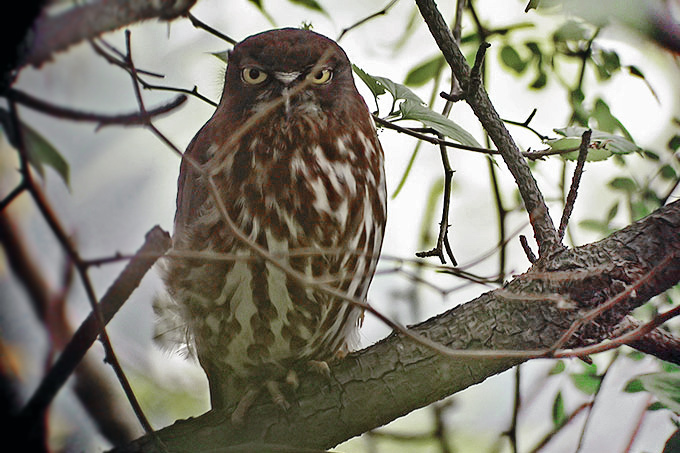
Socheong, May 20
With heavy overcast (and light fog) much of the day, an even heavier fall of migrants for several hours from the late morning, and 89 species were logged, including the Black Baza again (again briefly, when brownish-chestnut tone of underparts barring was noted), with a male Rufous-bellied Woodpecker also seen at the exact same spot!
In the small part of the island that was covered, 13 species of warbler were noted, including 100 Black-browed, 100+ Dusky, 70 Raddes', 120+ Arctic, and 80 Pale-legged Leaf, as well as a new national high count of 44+ Two-barred Greenish. Flycatchers were also present in good numbers, with 100+ Brown, 30 Grey-streaked, 30 Yellow-rumped, 8 Mugimaki and 8 Dark-sided and 4 Red-throated.
Other numerous species included Chestnut-flanked White-eye (200+), and Chestnut Bunting (150+), while further species of note included single Red-billed Starling, Chinese Blackbird, Black Drongo (in off the sea) and White-throated Rockthrush (a female).
Seungbong Island, May 20
Thick fog and cold air blanketed this pretty island of mixed woods,scrub, rice paddies and marsh, bringing an obvious influx of migrants, including 1 Amur Falcon, a Chinese Pond Heron, 2 Ashy Minivet, a lucionensis Brown Shrike, and a Northern Hawk-cuckoo (heard).
On the shore and adjacent rice paddy, 12 "Eastern" Oystercatchers, a Common Kingfisher, 2 Common Sandpipers, 2 Zitting Cisticola, 6 Buff-bellied Pipits, 1 Tristram's Bunting and a Grey Wagtail. In the woods, c.15 Grey-streaked Flycatchers predominated over 10 Yellow-rumped, 1 Asian Brown and 1 Mugimaki flycatchers.
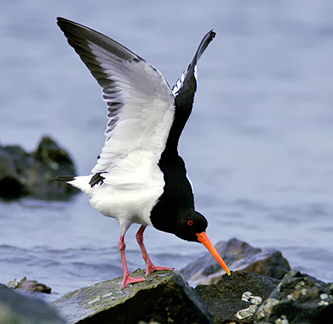
Photo Robin Newlin
Also 1 Grey-backed Thrush, 2 Siskins, a Grey-headed and a Great-spotted Woodpecker, ca. 20 Eastern Crowned, 15 Yellow-browed and several Arctic and Korean Bush Warblers.
Overhead passage included handfuls of Broad-billed Rollers, Black-naped Orioles & 4 Chinese Sparrowhawk.
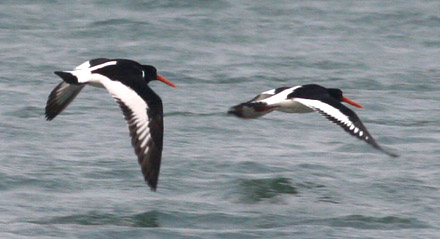
Photo © Tim Edelsten
Socheong, May 19
With a new ferry boat in service, reduced opportunities for seawatching, so only 3 breeding-plumaged Pacific Loon noted, along with a single Ancient Murrelet and 10 Streaked Shearwater.
On the island itself, very small numbers of a wide range of migrants, with best early on being single Black Drongo and a female-type Red Turtle Dove.
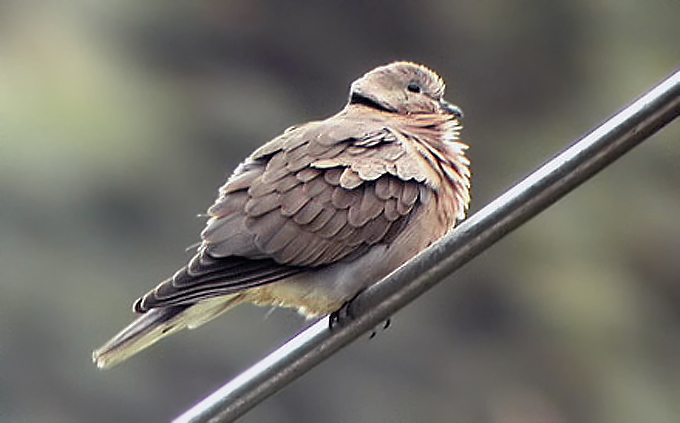
During the afternoon, a small arrival, with 25+ Brown and 10 Yellow-rumped Flycaychers noted, as well as a male White-throated Rockthrush, and small numbers of raptors, including 17 Crested Honey Buzzard, 2 Grey-faced Buzzard, 10+ Chinese Sparrowhawk, and outstanding highlight of the day, a Black Baza! Seen well but briefly twice in 2 minutes, no images of this most distinctive species were taken, but plumage details noted included the all-black head with white breast bib below, the dark and white barred underparts, and the large whiteish oval on the scapulars. This is the first record of the species in Korea known to Birds Korea.
Heuksan, May 18
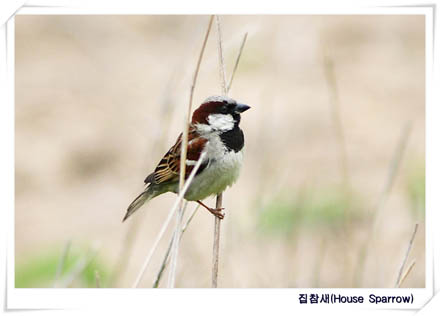
Photo © Kim Sung-Hyun (National Parks Migratory Bird Centre)
South Korea's first House Sparrow was found today by Ms. Kim Eon-Jeong on Heuksan Island.
Ganghwa, May 18
Although the rice-fields were largely devoid of passerines, highlights for the day included a singing Daurian Starling, 3 Chinese Penduline Tit, and on the tidal-flat 5 breeding-plumaged Saunders's Gull, 9 Black-faced Spoonbill and 5 Chinese Egret along with good numbers of more regular shorebirds (with eg 5000 Dunlin along one stretch).
Dong-mac, May 16
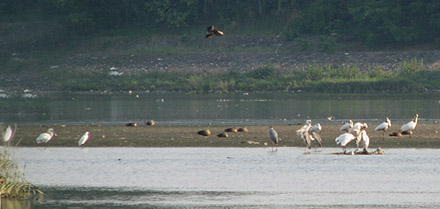
On the small lake by Dong-mac station there were still 8 Black-faced Spoonbills, which left and headed west at 19:10 towards the open sea.
Geum Estuary, May 17
More detailed data will be posted later, but outstanding highlight was AT LEAST 69 Nordmann's Greenshank counted at roost at Yubu Island.
Okgu, Saemangeum, May 15
Today, a remarkable count of 21 Spoon-billed Sandpipers at Okgu; also plenty of leg flag sightings (recent additions of past few days inc. Alaskan Dunlin, individually marked Dunlin, individually marked Great Knot etc...).
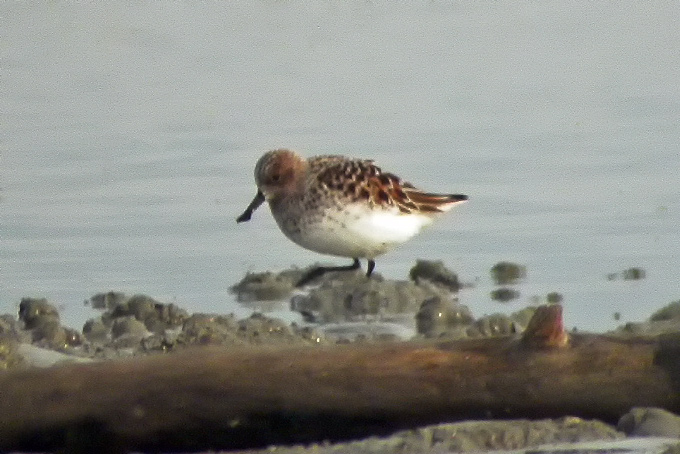
Cheonsu Bay, May 14
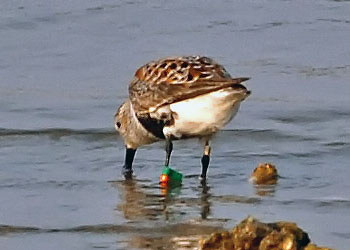
A banded Dunlin Photographed
Namyang Bay, May 14
1 Bar-tailed Godwit banded with green colored band seen.
Songdo, May 14
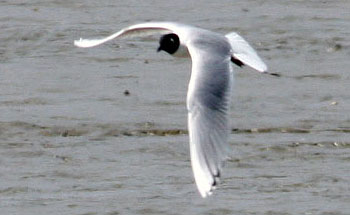
A similar range and number of birds as last week, however a marked increase in Mongolian Plovers and Terek Sandpipers, up to 100 of each. Also more Kentish Plovers present. 2000+ Dunlin still range over the mud, also ca. 20 foraging Saunder's Gulls. 7 Grey-tailed Tattlers were in their time-honoured place among the rocks.
7 Black-faced Spoonbills fed and rested on the lagoon, where Oriental Reed Warblers are now busy in the reeds.

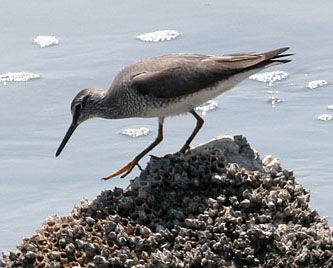
Seungbongdo, May 13 - 14
A weekend trip to Seungbongdo after a week of dry and settled weather held low expectations for any major falls of migrants. Numbers of birds were indeed low, but nevertheless of high quality.
May 13 (afternoon / evening).
The west/southwest side of the island produced 6 Eastern Oystercatchers, 5 Common Sandpipers, and small numbers of passerines; highlights were 1 Yellow-rumped and 2 Asian Brown Flycatchers, 2 Korean Bush and 7 Yellow-browed Warblers (singing), an Oriental Scops Owl (also heard only), a Greater Short-toed Lark, and a beautiful male Yellow-breasted Bunting.
May 14 (morning to late afternoon).
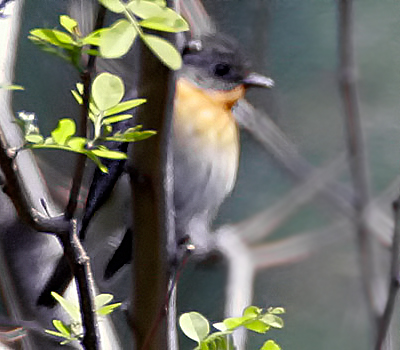
Photo © Robin Newlin
The day began with a surprise Amur Falcon (a beautiful male). Other highlights were 7 lucionensis Brown Shrike (including one with a white wing patch), 10 Yellow-browed, 1 Eastern Crowned and 1 (probable) Radde's Warbler, 5 Chinese Grosbeaks, 3 Grey-backed Thrush (heard), a White-throated Rock Thrush, 1 Chinese Sparrowhawk, 1 Grey-faced Buzzard, flyover Siskins and Bramblings (heard only), and a singing Eurasian Cuckoo (personal 1st for the spring).
Late in the afternoon, in a mix of second growth and mixed deciduous trees, 4 more Yellow-rumped, 1 Grey-spotted, 1 Mugimaki, and 3 Brown Flycatchers.
The outstanding highlight of the day was associating with this loose group: a brightly coloured male Hill Blue Flycatcher, Korea's first record. Robin has sent the following preliminary description: "I watched him through (10x42 Zeiss) binoculars. Bright dark blue body and wings, orange-red throat and breast, fading into white belly. No eye-ring. Faint and small extension of the orange down the flanks.The face area (behind beak, around eye) appeared rather dark, as did very top of crown (although there were some shadows from leaves or branches, which may have affected these impressions--but I don't think so)."

Mangyeung Estuary, May 13
After some filming with the Korean EBS TV organisation at the Geum in the morning, three teams counted several points (Okgu, Airport and Simpo) at the Mangyeung.
With the data still being processed, very approximately 95000 shorebirds were counted, with most numerous being Great Knot (52000) and Dunlin (44000). In addition, 7 Nordmann's Greenshank were logged, with a further single observed at the Geum.
Mokpo, May 11
A blue and white-flagged Dunlin was Photographed at Mokpo today by Andreas Kim. This is a flagging combination used in Taiwan, and is the first Taiwan-flagged Dunlin to be found in South Korea. There have, though, already been 12 Korean-flagged Dunlin sighted/recovered in Taiwan (thanks for information from Weitling Liu of the Taiwan Wader Study Group).

Eocheong, May 10
With heavy overnight rain lasting through till AM, followed by clearing conditions of fog banks and sunny spells, a big fall was anticipated...however, although diversity remained high, no species was present in very good numbers, with only e.g. shorebirds (e.g. 2 Pacific Golden Plover, 6 Grey-tailed Tattler, 5 Terek and 3 Sharp-tailed Sandpipers) and flycatchers obviously more numerous - with Mugimaki (9), Yellow-rumped (8), Brown (ca10), Grey-streaked (6), Red-throated (1) and Dark-sided (1) Flycatchers all present. Most intriguing was a female bittern seen very briefly in flight in heavy rain (possibly a Shrenck's, but perhaps more likely a Cinnamon), while best for the day was a superciliosus Brown Shrike (a "Japanese" subspecies which is apparently rather rarer in South Korea than suggested in our online id note on shrikes).
In addition, still at least 4 Black Drongo, one Chinese Blackbird, 3 Yellow Bunting, a House Swift, and single Chestnut-cheeked and Daurian Starlings, whilst a Little Cuckoo was the personal first of the year.
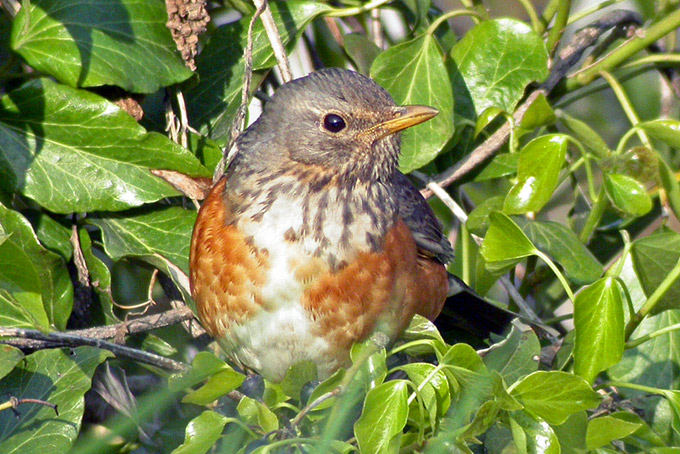

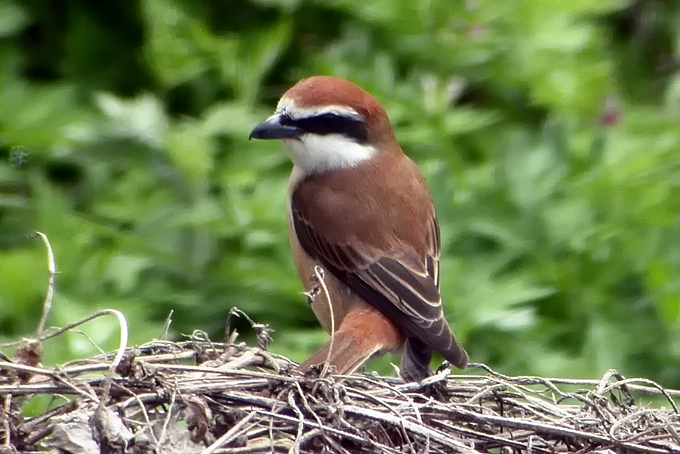
Eocheong Island, May 9
A clear morning, becoming gradually greyer through the afternoon, with rain showers by evening. An obvious reduction in diversity (as is often the case ahead of rain fronts), but still several species of note, including 4 Black Drongo still and a White-breasted Waterhen, with obvious highlight a Himalayan Swiftlet for 5 minutes in the early morning.
Other new arrivals included a Chinese Egret and an Eastern Oystercatcher, a male Chestnut-cheeked Starling, now 3 Yellow Bunting, and a handful of Yellow-rumped and Grey-streaked Flycatchers in the evening.

Eocheong Island, May 8
After an overcast early morning, a largely clear and sunny day, with light northerly winds. 96 species logged on the island, with Yellow-browed Warbler (ca 75) still the only fairly numerous passerine. Best for the day included the Ashy Drongo and 4 Black Drongo still, a female Shrenk's Bittern, a second-calendar year male Narcissus Flycatcher, 2 Yellow Bunting, 2 Red-billed Starling, an overflying Blyth's Pipit and the long-staying Black-faced Spooonbill still, while there were also an increased number of Broad-billed Roller (ca 25), Red Crossbill (22+, including at least one juvenile), and Chestnut-flanked White-eye (ca 20), along with 5+ Richard's Pipit, 2 Grey-faced Buzzard and 4 White-throated Needletails.
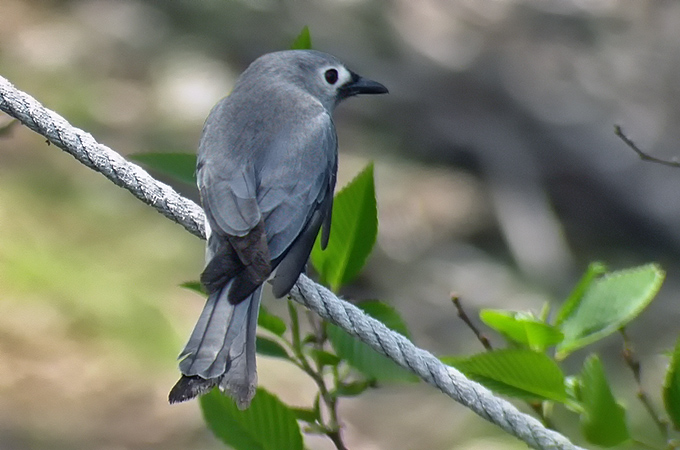
Eocheong Island, May 7
From the ferry, 20 Streaked Shearwater and no murrelets...on the island itself, ca 95 species, with species perhaps of most note including an Ashy Drongo (originally found by Chai Seung-Hoon) and 4 Black Drongo, a Baillon's Crake, 21+ Chinese Pond Heron, a White-breasted Waterhen, 2 Chinese Blackbird, a Hume's Leaf Warbler, an Amur Falcon, a Wryneck, a Yellow Bunting, and a small collection of shorebirds on the beach, including 8 Sharp-tailed Sandpiper and single Red-necked Stint, Common Greenshank, Terek, Broad-billed and Marsh Sandpipers.
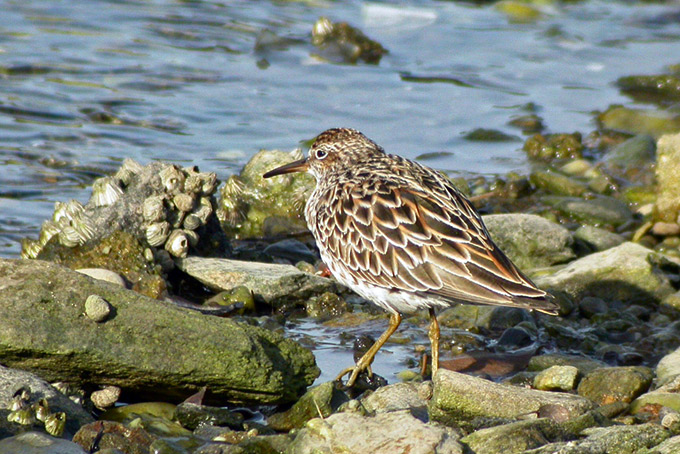
Oh-seong and Na-po Village reservoir, May 7
In Oh-seong Mountain's vicinity there was one Striated Heron. Common Cuckoos have started calling. In a reservoir near Na-po Village a single Baikal Teal and 17+ Falcated Teal outnumbered the few Mallards that remained.
May 6, Kunsan Airport adjacent hill
A single Black-capped Kingfisher as well as a Common Kingfisher were seen. Grey Starlings now noticed in several locations. Near a stream that drains off a few rice paddies a grassy area continues to grow. One Painted Snipe (perhaps a female) was watched in near twilight with light rain and wind.
May 5, Keum Tidal and Oh-seong Mountain vicinity
Congregations of a couple of score of Spotted Redshank made a line of black in the distance on the tidal flats, a somewhat late pair of Pintails, and scores of Sharp-tailed Sandpipers were seen. Near Oh-seong Mountain Indian Cuckoos and one Oriental Cuckoo were heard. Several Oriental Scops Owls were calling, too. Two male Grey-backed Thrushes were seen and several were heard singing. A few White's/Scaly Thrushes were seen and heard. Broad-billed Rollers were overhead. Black-naped Orioles and Azure-winged Magpies were plentiful. On top of the Mountain an Asian Brown Flycatcher was watched well.
Gunsan Airport, May 7
Pretty quiet for the last few days, but we saw a male Black Paradise Flycatcher (May 5) by the airport and a Black-winged Stilt, 7 Saunder's Gulls, and a Black-capped Kingfisher hunting frogs (May 7) in the Industrial Zone.
Song Do, May 7

The "reclamation mudflat" is very dried out now, with only small numbers of birds: 1 Eurasian Curlew, 3 Saunder's Gulls, 5 Terek Sandpipers, 5 Grey Plovers and 10 Whimbrel. Compare this to the thousands of shorebirds using it on almost the same date last year!
The lagoon held some Spot-billed Ducks and lingering Common Teals, plus a handful of Common Sandpipers.
On the overgrown golf course, a single eunomous Dusky Thrush, also 1 Yellow-browed and 1 Eastern-Crowned Warbler, as well as a Sooty Flycatcher.
Shorebirds have started to use an enclosed area of mud at Aham-do (which we think they never used in previous year). Despite disturbance from aircraft and people, we counted 2300 Dunlin, 540 Great Knot, 280 Bar-tailed Godwit, 60+ Little Tern, 50 Whimbrel, 35 Grey Plover, 20 Mongolian Plover, 18 Terek Sandpipers, 15 Far Eastern Curlew, and single numbers of Common Greenshank, Eurasian Curlew, Red-necked Stint, Red Knot, Great Cormorant, Mongolian and Black-tailed Gulls. Also 3 Kentish Plover, 2 Ruddy Turnstone, 2 "Eastern" Oystercatcher and a Striated Heron.
73 Saunders's Gulls was encouraging considering the damage done to the area. In breeding plumage, seen copulating and greeting in pairs, it is likely that they are still nesting on the nearby colony - although in reduced numbers.
Dongjin Estuary, May 6
In heavy rain, an hour at one of the Dongjin sites, where ca 18000 shorebirds (mostly Dunlin), now with ca 100 Sharp-tailed Sandpiper mixed in and at least one breeding-plumaged Asiatic Dowitcher still.
In addition, Mr. Chai Seung-Hoon on Eocheong Island reported by phone that there was an Ashy Drongo there, while the Spangled Drongo was still present at Gunsan airport on at least03 May (via Peter Nebel).
East Seoul, May 5

The woods in East Seoul showed a mix of change and continuity. No sign of the Rufous-bellied Woodpecker (which was last sen on May 2) but Great Spotted and Grey-headed Woodpeckers made appearances. Siberian Blue Robins and Yellow-browed Warblers were present but much more quiet. Black-naped Orioles, Grey-backed and Pale Thrushes and Blue and White Flycatchers were still around and vocal. New visitors were a calling Hoopoe and 4 Mugimaki Flycatchers.
A surprise was the (re)appearance of 15 Japanese Waxwings.
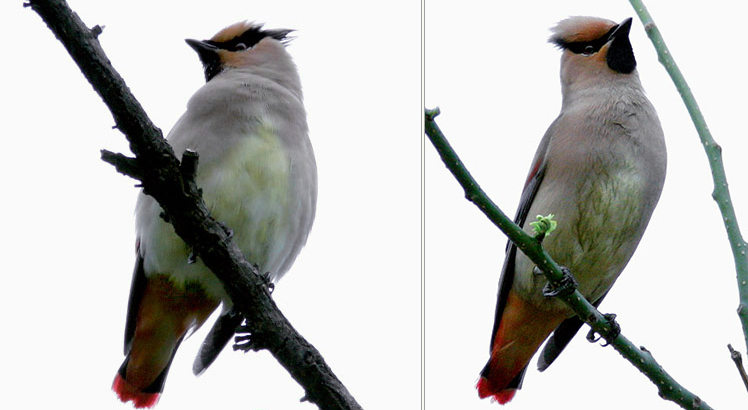
Hong Island, May 4
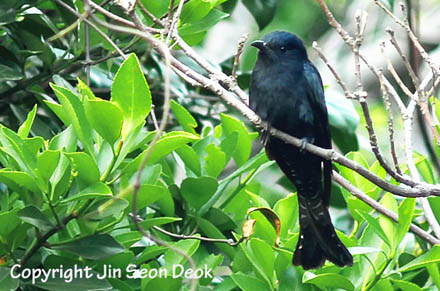
Photo © Jin Seon Deok
Asian Drongo Cuckoo Surniculus lugubris, adult, 4 May 2006, Hong Island found and Photographed by Jin Seon Deok, with identification confirmed (and permission given to post the Photograph below) by Kim Sung-Hyun and Park Jong-Gil of the National Parks Migatory Bird Center (Hong Island).
Eocheong-do, May 1 - 4
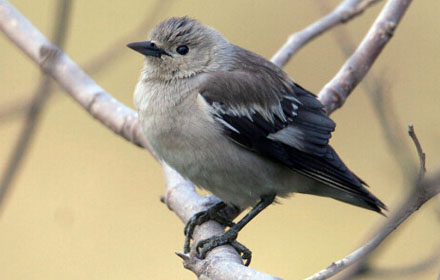
Highlights included the following notable records: 1 Ashy Drongo, 1 Black Drongo, 11 Chinese Pond Heron, 16 Black-naped Oriole, and one each of Baillon's Crake, Greater Short-toed Lark, Common Rosefinch, and Daurian Starling.
Heuksan Island, May 3

An adult male Bearded Tit Panurus biarmicus Photographed on Heuksan. The second national record it was first found on May 1 by Park Young-Wook and was still present until at least May 3.
Gunsan Airport, May 2

One Spangled Drongo, seen and well-Photographed. This is the least recorded of the three drongo species seen in South Korea (see eg Records of Drongos in Spring 2003).
Weiyeon Island, May 1
Korea's second Lesser Coucal Centropus bengalensis was found and Photographed today on Weiyeon Island (Chungcheongnam Province) - the first was found dead on Geokrelbiyel Do (a small island close to Ocheong Island) on June09 2005.

Birds Korea 1108 Ho, 3 Dong, Samick Tower Apt., 148-22, Namcheon-Dong, Su-Young-Gu
Busan, 618-762 Republic of Korea





